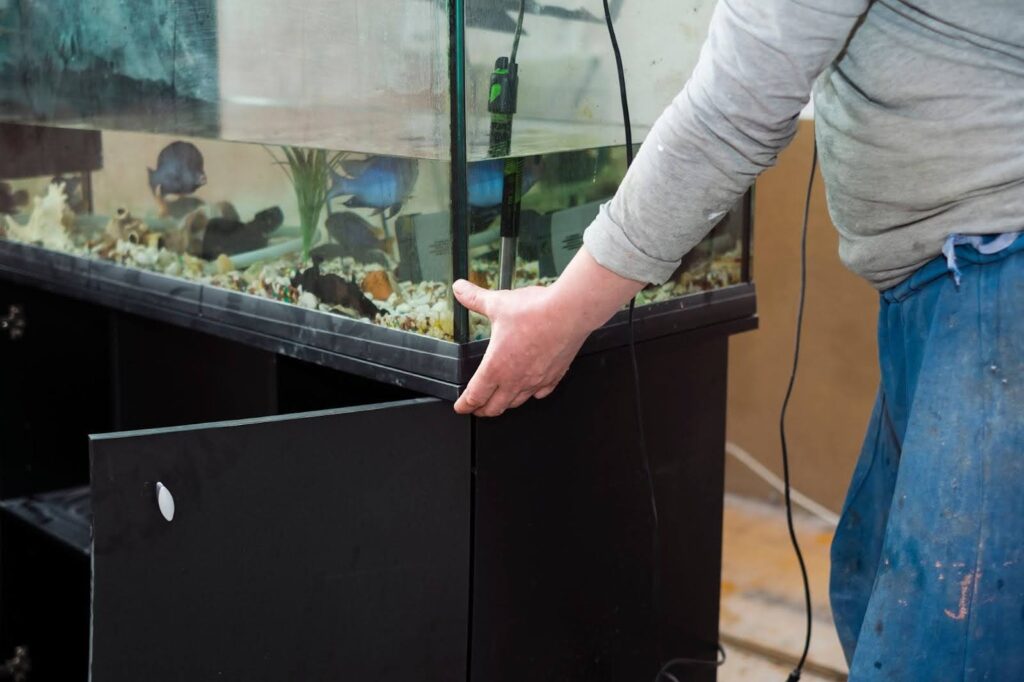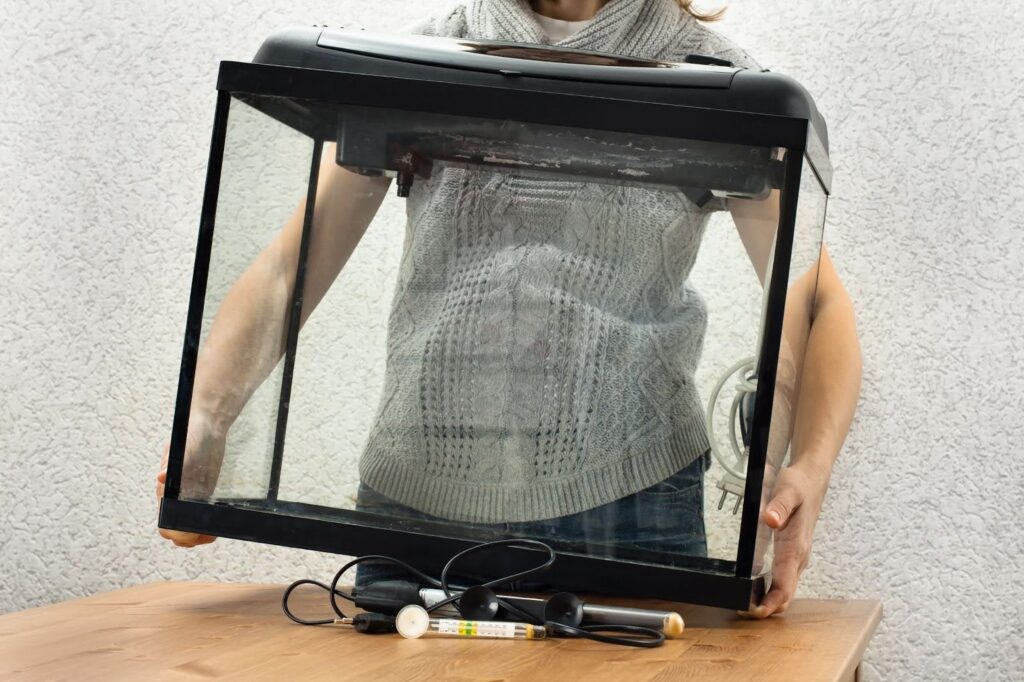
Moving to a new home is often a complex process, and when pets are involved, the challenge becomes even greater. For those with aquariums, one major question arises: how to transport fish when moving? Fish are delicate creatures that require a stable environment, making their transport more complicated than traditional pets like cats or dogs. Any drastic change in water quality or temperature could lead to stress or worse, making it critical to plan carefully.
In this guide, we’ll walk you through the best practices to ensure the safe relocation of your aquatic friends. Whether you’re moving across town or across the country, learning how to move with fish is essential to keep them healthy and safe. By following the right steps, you can minimize the stress for both you and your fish during the move, ensuring a smooth transition to your new home.
Pre-Move Preparations for Fish
Before the big day, it’s important to prepare your fish and tank for the move. First, research how to transport your specific type of fish. Different species have varying levels of tolerance to water temperature and quality changes. For instance, freshwater fish may be more resilient than saltwater fish, so knowing the needs of your aquatic pets is crucial.
Begin by fasting your fish 24 to 48 hours before the move. This reduces waste production during transport, keeping the water cleaner and making the journey less stressful for your fish. It also helps minimize the chance of ammonia buildup in the water during transit.
Next, gather the essential supplies. You’ll need fish bags or containers, ideally made for transporting fish, along with rubber bands to secure the tops. You’ll also need portable water heaters, battery-operated air pumps, and a cooler or insulated box to maintain temperature and oxygen levels. Additionally, have separate containers for tank water, as well as for plants, gravel, and other tank equipment, which will help you reassemble your aquarium quickly once you arrive.
By organizing everything in advance, you’ll ensure a smoother transition for both you and your fish.
How to Move Fish Tanks Safely

One of the most important aspects of how to transport fish when moving is ensuring the safety of the fish tank itself. It’s crucial to remember that fish should never be transported in the tank. Instead, they should be placed in separate containers while the tank is disassembled for the move.
Start by removing the fish from the tank and placing them in pre-prepared fish bags or containers. Once your fish are safely stored, remove the water from the tank, saving a portion of it to refill once you reach your new home. Be sure to carefully pack the tank and all its components, including filters, heaters, and decorations.
When packing the tank, use padding such as bubble wrap or blankets to prevent breakage. If your tank is particularly large, it may be necessary to hire professional movers to ensure its safety during transit. A safe move for your tank means a safe move for your fish.
Transporting Fish on Moving Day
On moving day, how you transport your fish can significantly impact their health and safety. Fish should be moved in smaller, transport-friendly containers like fish bags, plastic containers, or buckets. Ideally, the containers should be filled with water from the original tank to minimize stress and shock from changes in water chemistry.
Make sure the containers are securely closed, using rubber bands for bags and lids for containers. Maintaining the right temperature is essential, especially if you’re moving a long distance. For short moves, insulated bags or boxes can help keep water temperatures stable. For longer moves, portable heaters or ice packs (depending on your fish’s temperature requirements) can be used to regulate the water temperature.
It’s also important to ensure your fish have access to oxygen. Battery-operated air pumps can help oxygenate the water, especially for longer trips. Keep the fish in a dark, quiet environment during the move to reduce stress. Place the containers in an area of the vehicle where they won’t be jostled excessively and check on them periodically to ensure they’re doing well.
By following these precautions, you’ll be able to transport your fish with minimal stress, ensuring they arrive safely at your new home.
Special Considerations for Long Distance Moves
Long-distance moves present additional challenges when figuring out how to transport fish when moving. The longer your journey, the greater the risk of stress or health issues for your fish. For trips that take several hours or even days, it’s crucial to plan for regular temperature checks, oxygen levels, and water changes.
If your move will take more than a day, consider packing extra water from your original tank in sealed containers for emergency water changes. If you’re driving, make periodic stops to check on the fish’s condition and, if necessary, add fresh oxygen using battery-powered air pumps. You may also need to bring along food for longer trips, though it’s generally best to keep your fish fasting if the journey is under 48 hours.
For extremely long relocations, particularly international moves, you may want to consult with a professional fish transport service to ensure the best possible care for your aquatic pets.
Unpacking and Reacclimating Your Fish
Once you’ve arrived at your new home, the next step is to safely acclimate your fish to their new environment. This process is just as important as packing them for the journey. Start by setting up the tank as quickly as possible, using the water you saved from the original tank. This will help maintain consistent water conditions and minimize stress.
Before placing your fish back in the tank, allow them to reacclimate to the water temperature and chemistry. Float the fish bags in the tank for 15-20 minutes to equalize the temperature, gradually adding small amounts of tank water into the bags every 5 minutes. This slow process will help your fish adjust to any minor differences in water chemistry between the containers and the new tank.
Once the acclimation process is complete, gently release the fish into their new home. Keep the tank lights off for the first few hours to reduce stress and allow them to explore the new environment at their own pace. Monitor them closely over the next 24-48 hours to ensure they’re adapting well to their new surroundings.
Common Mistakes to Avoid When Moving Fish
Even with careful planning, mistakes can happen during the process of how to move with fish. To ensure a smooth move, it’s essential to avoid these common errors:
- Transporting fish in the tank: Never attempt to move fish in their aquarium, as it poses a high risk of injury and stress.
- Using tap water in containers: Always use water from the original tank to fill transport containers. Tap water may contain harmful chemicals like chlorine that can be dangerous to fish.
- Skipping the acclimation process: When you arrive at your new home, take the time to slowly reacclimate your fish to the tank. Rushing this step can cause temperature shock and stress.
- Overfeeding before or during the move: Feeding your fish too much before the move can increase waste production, leading to poor water quality during transport.
By avoiding these mistakes, you can ensure a safer, less stressful move for your fish.
What to Do If a Fish Gets Sick After the Move
After moving, it’s not uncommon for fish to show signs of stress, which can lead to illness if not addressed quickly. If you notice any unusual behavior such as lethargy, loss of appetite, or erratic swimming, it’s important to take action immediately.
First, check the water conditions in the new tank, including temperature, pH, ammonia, and nitrate levels. Stress from the move may have disrupted the balance, so a water test is crucial. If the levels are off, perform a partial water change and adjust the conditions as necessary.
If your fish still show signs of illness, consider adding stress-reducing water treatments or consult a veterinarian specializing in aquatic pets. Early intervention can make a significant difference in recovery, so it’s important to act quickly if you notice any symptoms.
When to Seek Professional Help
In some cases, the safest way to move fish is to hire professional help. This option is particularly valuable for larger tanks, long-distance moves, or if you own sensitive or rare species. Professional fish transport services have the expertise and equipment needed to handle even the most complex moves.
They’ll ensure the right water conditions are maintained throughout the journey and may offer acclimation services when you arrive at your destination. Though it may add to the cost of the move, hiring professionals can offer peace of mind and a higher likelihood of a successful relocation for your fish.
Final Thoughts
By following these steps, from pre-move preparations to safe transport and acclimation, you can minimize stress and keep your aquatic pets healthy.
Moving with fish is no small feat – it’s a delicate balancing act that requires careful planning, precise execution, and a whole lot of patience. But here’s the good news: you don’t have to navigate these choppy waters alone!
At Qshark, we’re not just experts in boxes and furniture—we’re pros at handling specialized moves, including those involving aquariums and their finned inhabitants. Our team understands the unique challenges of transporting fish and can ensure your aquatic friends arrive at their new home safe and stress-free.
Let Qshark Moving handle the complexities while you focus on settling into your new space. Call Qshark now at (844) 326-7108, and We’ll ensure your fish remain happy and healthy throughout the journey.


